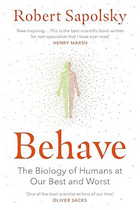Behave - The Biology of Humans at Our Best and Worst
This is not a book you can casually read before bed—at least not for me. It’s filled with a wealth of information on neuroscience, psychology, studies conducted, papers published, and more. It was very interesting, and I learned so much from it. It took me a while to read, as I had many interruptions, which meant I had to go back and reread several chapters.
The book is about why we behave the way we do—what makes us congenial, aggressive, possessive, or averse. The author explores how several factors influence our behavior. He starts by explaining what happens at the very moment we display a particular behavior, and then explains, how what happens - a few minutes, hours, days, and all the way back to how events during adolescence, or even in the womb, could have contributed to many of the reactions we show today.
The studies he cites are very interesting – like the one about the baby mice showing fear in the presence of a cat even though they had no previous experience or exposure to a cat. No adult mouse to show or tell them to fear a cat. Yet the first time a cat was placed outside the cage, the baby mice started to showfear – perhaps as means of survival. A strategy of evolution?
Then there is a whole chapter dedicated to how genetics is nothing without the environment, and the way they go hand in hand. Also very interesting. The role of the amygdala and the prefrontal cortex (PFC) is discussed in depth, particularly how neural plasticity plays a major role in how we overcome our fears and aversions. I especially enjoyed the chapters explaining the theory of mind.
The second part of the book discusses how we can use this biological information to make better judgments in the court of justice, but also how we must exercise discretion in doing so. He uses the example of paedophiles to show how they have a genetic tendency to be attracted to children, so if you go purely by science it is as if it is not the fault of these people. It is the insanity of the mind that makes them do it. But on the other hand not all people having this genetic anamoly choose to become offenders. It is what you choose to be. There are lot of things that can explain your behaviour and that of others, but in the end I believe you can choose who or what you want to be.
Then there is culture, religion, social status, wealth, etc - where and what you are born into and grow out of that influence why you behave the way you do. The author discusses this with insightful examples.
An excellent book with lots of thought-provoking content. However, you need time to read and reflect on it, and it’s even better if you have someone to discuss it with afterward.
Also read Determined - The Science of Life without Free Will
© 2025 Sindhuja Cheema Enzinger. All Rights Reserved.

